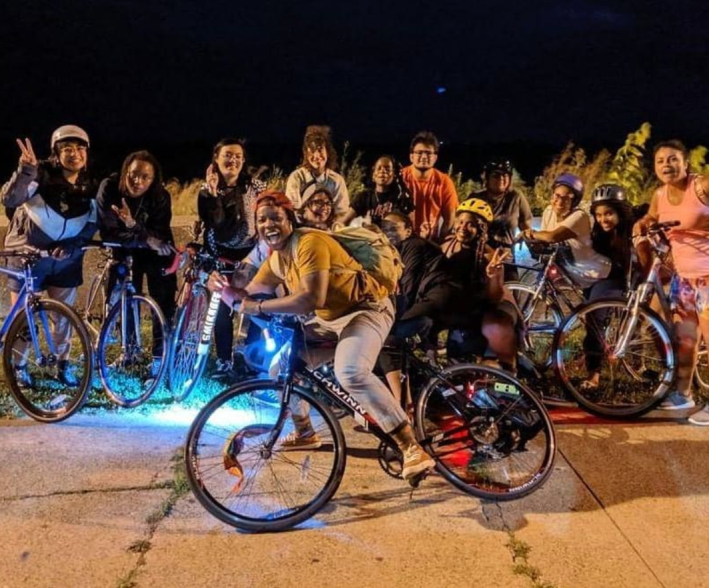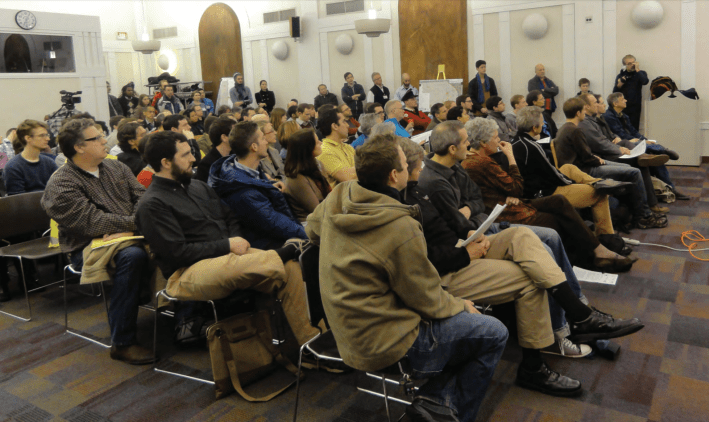Last Friday I had the opportunity to attend a mobility justice panel at the 10th annual Urban Innovation Symposium, an annual conference organized by the students in the UIC Urban Planning and Policy Student Association. I thought I had arrived in time to only catch the mobility justice panel but I was able to listen to the keynote speaker, Alden Loury, the senior editor on race, class, and communities for WBEZ Chicago.
Loury opened by discussing his childhood fascination with the layout of cities and how that led him to study architecture in college. Loury also spoke of his observations on race and physical space; as a child he noticed the difference in amenities in white neighborhoods and Black communities. Loury reminded the planners in the room of their power and impact on communities through the choices they make. I was struck by Loury’s citing of the Metropolitan Planning Council’s Cost of Segregation report which found that Chicagoland would see $4.4 billion in additional income, a 30 percent lower homicide rate, and 83,000 more bachelor’s degrees if the metropolitan area was less segregated. We can help achieve these gains through planning that seeks to address segregation and improve the quality of life for those on the margins.
The mobility justice panel opened with the acknowledgement that transportation planning has not produced beneficial outcomes for all communities. The panel was composed of Streetsblog Chicago writer Lynda Lopez, who also works as transportation manager for the Active Transportation Alliance and serves as the Southwest Side community rep for the Mayor's Bicycle Advisory Council; D’Frantz Smart, an organizer with 2WheelGods and WTF Bikexplorers; and Kate Lowe, professor of urban planning and policy at UIC. The panel was moderated by Stacey Meekins, director of transportation planning at Sam Schwartz Consulting.
Meekins started off by asking the panelists which communities they work with and what the biggest transportation gaps are for those communities. Lowe started off by stating that she works with various transportation-related nonprofits like the mobility justice group Equiticity and the Metropolitan Planning Council, and has worked with disenfranchised groups. She believes that the people who are structurally disadvantaged are the experts on what they need. According to Lowe, questions like, “How are people moving in and out of an area?" and "What modes are they using?” don't factor in how issues of job distribution across the region and interpersonal violence impact how people interact with transportation modes.
Lopez shared her experience of biking alongside commercial trucks and how it informs her thinking. “I think about the barriers the built environment can impose [that are a factor in] why people don't feel comfortable biking.”
Smart emphasized community and the role it plays in her organizing. “Visibility as a Black cyclist means a lot to me as someone biking on the South and West side.” D’Franz’s biking collective, 2WheelGods, centers Black, Brown, and queer people.

Meekins asked what needs to change within the transportation planning field, and what needs to change with the community engagement process. Lopez responded that we need to look at “who's in the room when transportation planning is happening,” both in terms of ensuring more women and people of color can access the transportation planning profession, and looking at how communities are being engaged. “You can't just expect people to come to you.”
I couldn't agree more. In looking over the The Chicago Streets for Cycling Plan 2020 I was struck by how many photos of the community input meetings that took place several years ago featured lots of white men, and the small numbers of attendees in the South and West side meetings. Images like that signaled to me that there was not a lot of targeted engagement, which is necessary for designing bike infrastructure that can meet the needs of a diverse group.

Smart shared similar sentiments, “When you come to the South and West sides and do your focus groups, don't seek me out. I am highly educated and own multiple bikes. You should be talking to people who have less privilege and social capital.” Smart shared her desire to do a pilot project tracking the biking routes of low-income riders on the South and West sides, looking at the average round-trip distance from home to work, and what their itineraries look like.
Lowe stated that more of our transportation planning should focus on solving problems and meeting needs. She argued that the the CTA's current $2.1 billion Red and Purple Modernization project will mostly benefit North Siders who already live in transit-rich areas. One could wonder how else that money could have been spent and what gaps in our system could have been filled. [In recent years the CTA has spent $495 million on renovating the south Red Line and $280 million on rebuilding the 95th Street Red Line station, and the agency is currently seeking $2.3 billion to extend the Red Line south to 130th Street. - ed.]
I was lucky enough to be the only person able to ask a question of the panel. I asked the panelists about their hopes for the CTA’s bus rider survey and other opportunities for the agency to meaningfully engage with riders. Lopez argued that we cannot view this survey as the be-all and end-all of efforts to improve bus service. She cited grassroots bus campaigns such as the Little Village Environmental Justice Organization’s restoration of 31st street bus service, and North Side residents' lobbying for restoration of the full Lincoln Avenue bus route as examples of ways bus service can be improved outside of depending on institutions for the bulk of change.
Lowe said she's hopeful about change given the increasing dialogue about bus service in the city. “The [upcoming] CTA bus report is an important step. There's an inside and outside game.” I'm grateful that I was able to attend this panel and consider how my own work can be further influenced, guided, and articulated by the perspectives shared.






